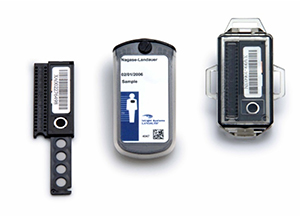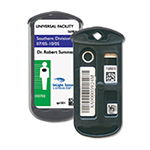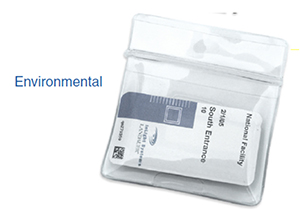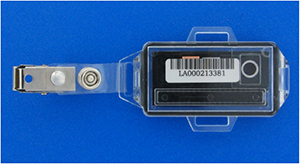OSL dosimeters are designed to provide X, gamma, beta and neutron radiation monitoring using OSL technology. These dosimeters are suitable in personnel monitoring, environmental monitoring.
InLight® Dosimeter (Personnel Monitoring)


InLight dosimeters are designed to provide X, Gamma and Beta radiation personnel monitoring using OSL technology.
InLight dosimeters are built on an assembly case component with metal and plastic filters along with a four-positioned aluminum oxide detector slide. These filters can provide information about the nature and energy of radiation during exposure.
Specifications:
| Radiation Type | Energy Range | Minimum Dose Equivalent Reported |
|---|---|---|
| Photon(x or gamma ray) | 5 keV to 20 MeV | 5 mrem (50 μSV) |
| Beta Particle | 150 keV to 10 MeV (expressed as average energy) |
10 mrem (100 μSV) |
KEY FEATURES & ADVANTAGES
- Nondestructive readout: Allows for reanalysis and reuse
- Accurate measurement across a wide dose range.
- No need to anneal every time the dosimeter will be exposed to ionizing radiation
- Element correction factors are not required
- Engraved 2D barcode identifies dosimeter sensitivity
- Minimal fading
- Dosimeter archiving is possible
- Dosimeters are durable: Shock resistant, moisture resistant, high temperature tolerance.
- No required heating parameters and gas to maintain
- Effective replacement for older radiation measurement technology (e.g., TLD)
InLight® Environmental Dosimeter

The InLight Environmental dosimeter is specifically designed to be used for monitoring environmental radiation exposure.
The badge consists of a plastic envelope, which can be sealed by the user to hold a dosimeter and a label.
Specifications:
| Radiation Type | Energy Range | Minimum Ambient Dose Equivalent Reported |
|---|---|---|
| Photon(x or gamma ray) | 5 keV to 20 MeV | 5 mrem (50 μSV) |
| High Sensitivity: 0.1 mrem(1 μSv) | ||
| Beta Particle | 150 keV to 10 MeV (expressed as average energy) |
10 mrem (100 μSV) |
| High Sensitivity: 20 mrem(200 μSV) |
KEY FEATURES & ADVANTAGES
- Nondestructive readout: Allows for reanalysis and reuse
- Accurate measurement across a wide dose range.
- No need to anneal every time the dosimeter will be exposed to ionizing radiation
- Element correction factors are not required
- Engraved 2D barcode identifies dosimeter sensitivity
- Minimal fading
- Dosimeter archiving is possible
- Dosimeters are durable: Shock resistant, moisture resistant, high temperature tolerance.
- No required heating parameters and gas to maintain
- Effective replacement for older radiation measurement technology (e.g., TLD)
InLight® Albedo Neutron dosimeter (OSLN)
The InLight® Albedo neutron dosimeter is capable of measuring radiation doses received from beta, photon and neutron radiation fields. It is specifically designed to be used in neutron dosimetry and is capable of detecting mixed radiation fields.

The InLight® – OSLN is capable of measuring in the following energy range:
| FIELD | ENERGY RANGE |
|---|---|
| BETA | 680 keV Emax(227 keV Eave) - 2284 keV Emax (761 keV Eave) |
| PHOTON | 16 keV - 1250 keV |
| NEUTRON | 40 keV - 5000keV |
The OSLN material is made up of Al2O3:C coated with 6Li2 CO3 to make the Al2O3:C sensitive to neutrons. The OSLN element is located in read position 2 (E2). No hardware modifications are required for the reader. A simple update in the software allows for full analysis of the OSLN dosimeter.
KEY FEATURES & ADVANTAGES
- Nondestructive readout: Allows for reanalysis and reuse
- Accurate measurement across a wide dose range.
- No need to anneal every time the dosimeter will be exposed to ionizing radiation
- Element correction factors are not required
- Engraved 2D barcode identifies dosimeter sensitivity
- Minimal fading
- Dosimeter archiving is possible
- Dosimeters are durable: Shock resistant, moisture resistant, high temperature tolerance.
- No required heating parameters and gas to maintain
- Effective replacement for older radiation measurement technology (e.g., TLD)